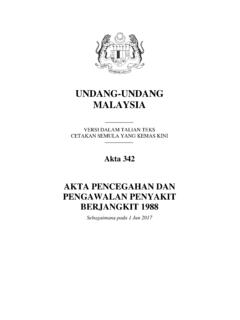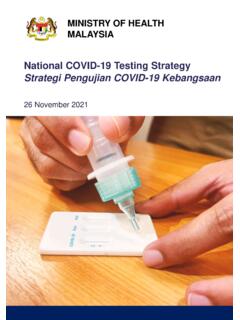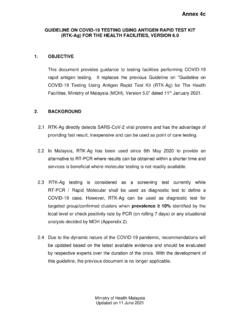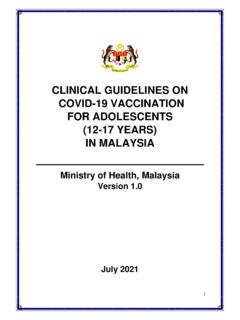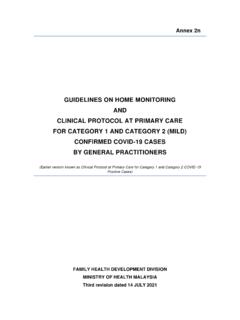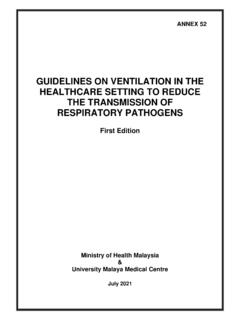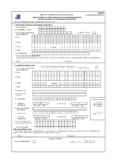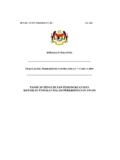Transcription of ANNEX 4c : GUIDELINE ON COVID-19 ... - COVID-19 Malaysia
1 1 ANNEX 4c : GUIDELINE ON COVID-19 TESTING USING ANTIGEN RAPID TEST KIT (RTK-Ag) FOR THE HEALTH FACILITIES, MINISTRY OF Malaysia VERSION 1. OBJECTIVE This revised GUIDELINE is aimed to replace the previous GUIDELINE on GUIDELINE on COVID-19 Testing Using Antigen Rapid Test Kit (RTK-Ag) for The Health Facilities, Ministry of Malaysia , Version dated 23rd July 2020. 2. BACKGROUND RTK-Ag has the advantage of detecting COVID-19 outbreaks quickly and in large quantities. Malaysia has been using RTK-Ag since 6th May 2020. The RTK-Ag used has undergone re-evaluation by the IMR and the results are satisfactory and within the Ministry of Health s (MOH) minimum sensitivity and specificity values. Limit of detection for RTK-Ag is currently at Cycle Treshold (Ct) value of 30. Any Ct value above 30 is unable to be detected by RTK-Ag.
2 From this evaluation, the sensitivity is raised to 90%. In terms of viral copy number, Ct value of 30 is equivalent to about 300-400 viral copy numbers on the Nasopharyngeal Sample (NPS). As compared to RT-PCR, it involves amplification step and it s limit of detection is about 4-5 viral copy numbers. An evaluation on specifity was also carried out using other respiratory viruses including influenza A pdm01, influenza A H3, Influenza B and Adenovirus. The specificity is 100% as the RTK-Ag did not detect any of those viruses. However, other respiratory viruses such as parainfluenza, metapneumovirus and community associated coronavirus were unable to be performed in this evaluation. RTK-Ag and RT-PCR tests are performed on different platform. Setting up RTK-Ag is to provide an alternative to RT-PCR where results can be obtained within a shorter time and services is beneficial where molecular testing is not available.
3 Nevertheless, due to its limitation in sensitivity and detection range of Ct value, testing using RTK-Ag shall be considered as a screening test and RT-PCR is used as confirmatory test to define a COVID-19 case. 2 A local unpublished study has shown that the same buffer solution of RTK-Ag can be used for RT-PCR testing. This study was done on 91 known positive samples. All of them were previously positive with lower ct values of 13-22 on 26th May 2020 and when re-tested with RTK-Ag and RT-PCR (using same buffer solution of RTK-Ag) 2 weeks apart showed valid results. Since the sample used is from the Nasopharyngeal Swab (NPS)- an area with high potential for viral content, sampling should be performed by fully trained health personnel using appropriate Personal Protective Equipment (PPE). The test should be conducted in the Biological Safety Cabinet (BSC) class II as there is a high risk of spilling the specimen during the mixing process between the swab and extraction buffer solution.
4 This GUIDELINE therefore is aimed at enhancing the previous GUIDELINE on testing COVID-19 using RTK-Ag. Due to the dynamic nature of the COVID-19 pandemic, recommendations are meant to be refined based on the latest available evidence and should be evaluated by respective experts over the duration of the crisis. With the development of the version GUIDELINE , the previous document is no longer applicable. 3. IMPLEMENTATION Indication The use of RTK-Ag is made priority in cases or samples that require urgent result for a prompt patient management to be given. The list of appropriate cases / samples using RTK-Ag is as follows i. Screening for Emergency and semi-emergency procedures or surgical cases with high probability of COVID-19 infection. (Garis Panduan Versi : Pengendalian Prosedur atau Pembedahan Semasa Wabak COVID19 di Hospital Kementerian Kesihatan Malaysia ).
5 Ii. Screening for Brought in dead (BID) cases with high probability or high suspicion of COVID-19 . 3 iii. Screening for Acute Respiratory Infection (ARI) following GUIDELINE on Management of Patient Suspected COVID-19 in Health Clinic by Family Health Development Division and Disease Control Division, MOH. iv. A wider coverage for screening in the area of Enforced Movement Control (EMCO). v. Screening at the country s entry point . vi. Screening identified or determined by MOH. However, any pre-procedure or pre-operation related to transplant cases will be screened using RT-PCR instead of RTK-Ag. COVID-19 testing for healthcare workers (HCW) shall remain using RT-PCR as it is regarded as one of the high risk groups. It is important to reduce the risk of having an outbreak within MOH s facilities which may cause a great impact to healthcare deliveries.
6 This is also in line with the current policy of two sampling (on day 3 and day 5 after contact) for HCW, in which the test can be done using paired-sample testing. The usage of rRT-PCR is also recommended to screen for Severe Acute Respiratory Illness (SARI) cases as the severe symptoms and presentations in SARI patients is highly suspicious of COVID-19 . Requirements Sampling procedure should be done by a trained personnel and usage of appropriate PPE shall be ensured. ( Recommended PPE to be used when managing Patient Under Investigation (PUI) / Confirmed COVID-19 & Severe Acute Respiratory Infection (SARI) / Influenza Like Illness (ILI) Patients in Healthcare Facilities 21 April 2020) Request for RTK-Ag testing should be informed to the Lab Personnel. Laboratory is responsible to provide suitable swab for NPS and empty container upon request.
7 Usage of Falcon tube is preferable or any empty container with a length of at least 9 cm can be considered as alternative. 4 The testing shall be carried out using BSC in the laboratory due to safety reasons. The testing shall be done by a trained laboratory staff with appropriate PPE. Testing using RTK-Ag and its result needs to be registered in Sistem Informasi Makmal Kesihatan awam (SIMKA) Outbreak. Preparation and Test Procedure The sample should be sent in plain container and not in VTM. Heavily blood stained swab shall be rejected as it may give false results. The laboratory personnel shall carefully check the expiry date at the back of the foil pouch. Do not use the kit if expiry date has passed. The test device and the desiccant shall as well be checked. Yellow coloured desiccant indicates valid test device while green coloured desiccant indicates invalid test device.
8 Detailed test procedure is as explained in the flow chart of RTK-Ag Testing for COVID-19 for health facilities. Swab, swab container, test device, extraction buffer tube and nozzle cap shall be discarded into biohazard bag once they are used and sealed properly to avoid exposure to other staff. 5 Flow Chart Using COVID-19 RTK-Ag Testing 6 FLOW CHART OF COVID-19 RAPID TEST KIT (RTK) ANTIGEN TESTING FOR MOH ^ HEALTH FACILITIES AND RESULT INTERPRETATION Ensure full PPE when collecting specimen. Perform nasopharyngeal swab (NPS) Result Place the swab in the container and send to the laboratory with ice (triple packaging) after the specimen is collected. Keep swab at temperature 2-8 C. keep specimen at 4C Receive specimen in the lab. Register specimen in SIMKA.
9 Perform test in BSC class II Ensure full PPE during processing Drop extracted specimen (3 drops) in specimen well. Read within 15-30 minutes by 2 personnel advisably Put swab into extraction buffer tube, stir them well in an angled position. Remove the swab while squeezing the sides of the tube to extract the liquid from the swab. Press the nozzle cap tightly onto the tube . Fill up request form Inform lab, collect swab and container from Lab Both C and T-line appear Only C-line appears Only T-line appears 7 FLOW CHART OF COVID-19 RAPID TEST KIT (RTK) ANTIGEN TESTING FOR MOH S HEALTH FACILITIES AND RESULT INTERPRETATION No No Yes Yes Positive -To report in SIMKA as positive Negative Asymptomatic Symptomatic No evidence of COVID-19 infection. **Those fall under HSO will repeat testing according to existing policies and guidelines.
10 Send new sample for RT-PCR Invalid test To repeat test RTK-Ag using a new sample *Repeat RT-PCR using same buffer solution - the leftover buffer solution should be sent to hospital s laboratory where the positive subject is referred to. - the floc of the swab need to be squeezed as much as possible to ensure most buffer is released into the tube, - the buffer tube must be labelled with name, IC number of subject - the lid of the buffer tube must be sealed with parafilm and placed in biohazard bag and packed in triple packaging, and send on ice 2o 8o C - the package must be enclosed with a copy of the request form. ** ANNEX 2, Guidelines COVID-19 Management in Malaysia RT-PCR using the *SAME buffer solution AND a NEW NPS/OPS sample within 24hrs Both C and T-line appear Only C-line appears Only T-line appears Detected -To notify CPRC as confirmed case Not detected Symptomatic **Refer to Annex2 Asymptomatic Repeat RT-PCR at 24-48hrs Detected -To notify CPRC as confirmed case Not detected **Refer to Annex2 Not detected Detected -To Notify CPRC as confirmed case **Refer to Annex2 No evidence of COVID-19 infection No evidence of COVID-19 infection **Refer to Annex2 No evidence of COVID-19 infection 8 Interpretation of Test Result Advisably, the result shall be read by 2 lab personnel.
